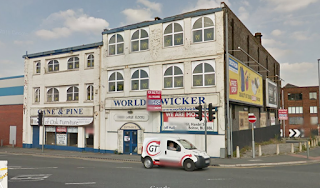The World Of Wicker premises on Manchester Road
pictured in September 2014 (copyright Google Street View) looking most unlike the venue for a gig by
mid-sixties rockers The Pretty Things, a band still going in 2015.
More a club than a pub, the Boneyard – or the Caroline
Lounge as it was also known – is one of Bolton’s lesser-known licensed premises
and it was in existence for just a few years. A number of comments appeared on the Manchester Beat website about the Boneyard in 2012. [1]
Numbers 21 and 23 Manchester Road date back to the
late-nineteenth century and other than their time as the Boneyard they have been
either commercial or retail premises for the whole of that period. For
instance, by 1905, number 21 was occupied by a warehouse owned by Henry Coates
and Sons, while the printing firm of Ferguson and Sons was at number 23. Three
more buildings, numbered 25, 27 and 29, went down to the junction with Lower
Bridgeman Street. They included smallware dealers Gregory & Porritts at
number 25 which also housed the Bolton offices of the Manchester Evening
Chronicle. In 1924, Coates and Sons were still at number 21 and a cotton waste
dealer named Charles Crook was at number 23. Gregory & Porritts had moved
on, though the Chronicle office was still there.
Maps of the area in the 1950s show that 21 to 25 were
all one premises but around 1964 it became the Boneyard
Club.
Writing on Manchester Beat in 2012, one of the
Boneyard’s bouncers, Jack Stokes, says that the club's owners were Terry and Pauline
Allan. For Jack, the most memorable night was a gig by the Pretty Things.
“Viv
Prince on drums was amazing. I had my back up against his bass drum to stop it
falling off. The crowd was going wild in front of me, he was lathered in sweat,
so was I.”
The Pretty Things were formed in London in 1963 and
began to have chart hits in 1964 which is possibly when the Bolton gig took
place.
There were two rooms at the Boneyard. A large room
where punters would just sit on the floor and a smaller room which had coffins
for tables. The venue was used by mods who would park their scooters outside
and it was noted for its all-nighters which began at midnight and ended at 8am.
Dave Evans points out on Manchester Beat that the
Boneyard had coffins for tables and that he often wore a coffin-shaped necklace
that he made itself. But it didn’t go down well with the door staff when the
Boneyard became the Caroline Lounge after a change of ownership.
An entry on the Soulbot website adds: “Although it was
not a cellar dive, you reached it by a set of stairs going up and over a
musical instruments store, it was one of THE places to go to.” [2]
However, Derek Austin writes on the I Belong To Bolton Facebook page that the Boneyard was owned by his second cousin Terry Edwards: [3]
"I went to the opening night when I was 14 years old. The two bands that played that night were the Toggery Five and the Dave Plum Stones."
Derek added:
"The DJ sat in a church pulpit! I saw the Pretty Things there a few weeks after the place opened. Jimmy Saville performed the 'official' opening ceremony, but I didn't go to that. A few of my grandmother's young female employees were there and Saville wanted to take them on to a club in Manchester called Beat City. Luckily for them, they declined!"
Christine Bailey said:
"Regularly went to the Boneyard on a Friday night. I worked in the cloakroom on the Sunday afternoon sessions when the 'all nighter Mods' from The Twisted Wheel in Manchester roared into Bolton on their Lambrettas. Happy crazy days."
The name was perhaps inspired by the success of the
Radio Caroline pirate radio ship which pre-dated Radio 1 and introduced popular
music radio into the UK from 1964 onwards. However, the Manchester Soul website
claims the Boneyard was a nickname and that the Caroline Lounge was the club’s
real name for the whole of its existence. [4]
We don’t know when the Boneyard/Caroline Lounge closed. The
musical instrument store referred to was Woods which remained at the premises
until the late-eighties. World Of Wicker then took over before
moving to Falcon Mill, Halliwell in November 2013.
There’s very little information about the Boneyard or
the Caroline Lounge. Any memories would be welcome.
[1] Manchester Beat. Accessed 5 August 2015. The site also contains contributions on a number of other Bolton club venues in the sixties including the
Cromwellian, the Blue Lagoon and the Bolton Casino. Click here for the full list.













